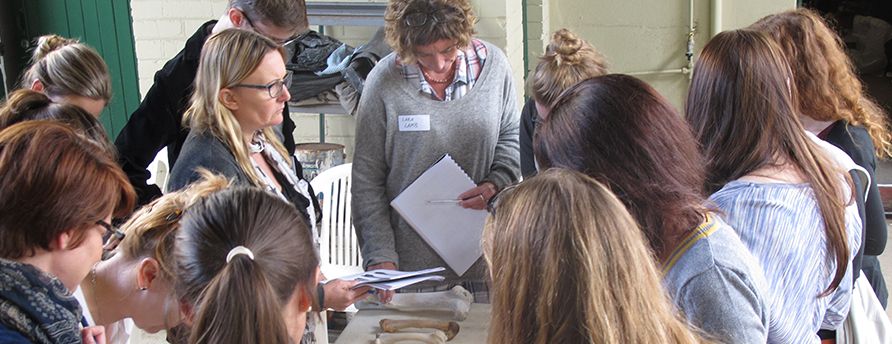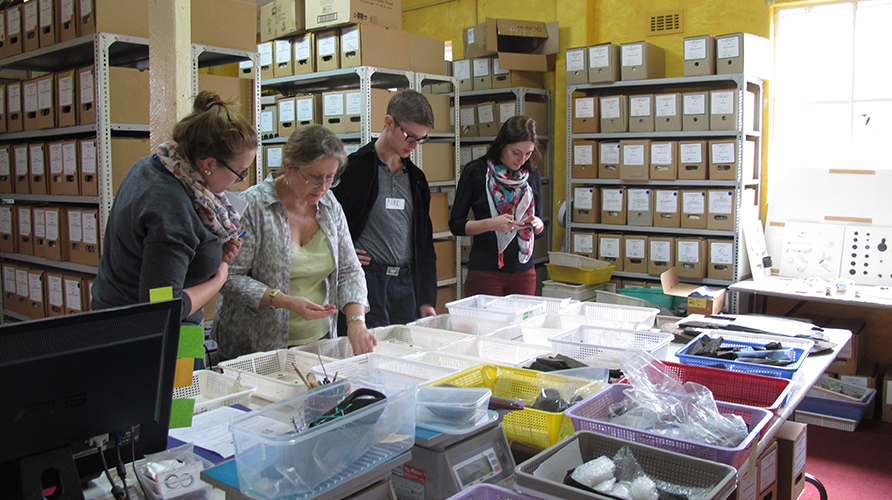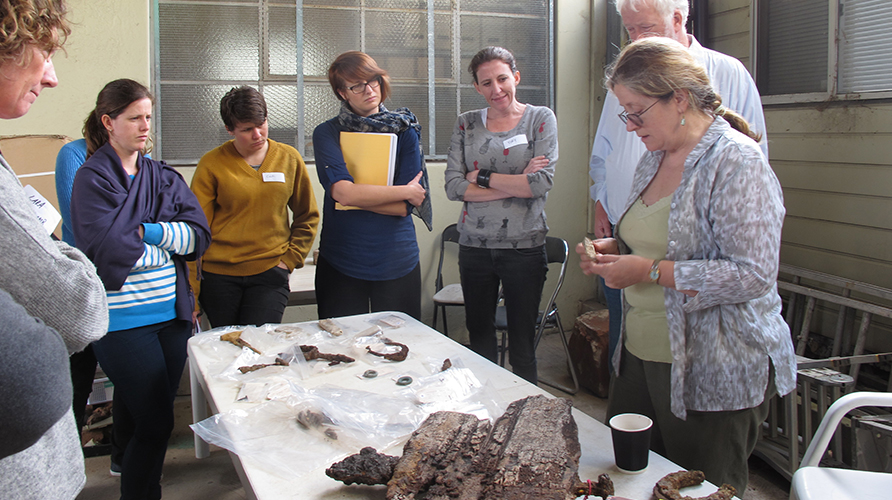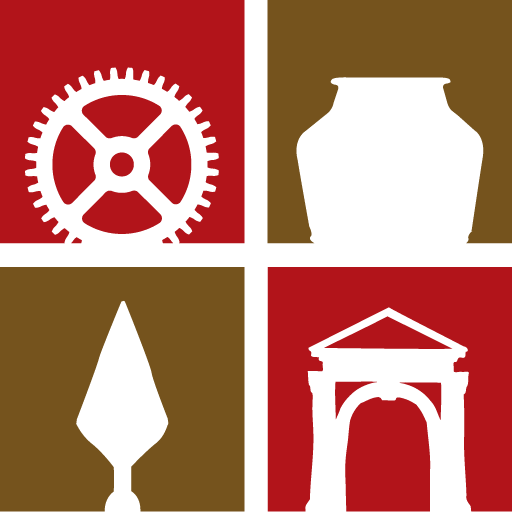
Another successful Artefacts Workshop was held in April this year, hosted by Casey & Lowe in Leichhardt, Sydney. This was the second such event, following a similar workshop held last November.
With record attendance and guest speakers bringing a multitude of skills to the table, all had a busy and informative weekend.
After a quick coffee, the morning started with Jeanne Harris, from Urban Analysts, delivering the first of her two PowerPoint presentations. She started the day with glass, expanding on our understanding of bottles, lamp glass and tableware. She focused on the diagnostic components of the items, taking us chronologically through their development of manufacture, allowing us to understand the features and so enabling us to identify them for a more precise dating range. This was then put to practice as we made our way to the courtyard for a show and tell. We were each given the opportunity to examine a bottle or piece of glassware and work through the diagnostic evidence to identify the piece before presenting it to the rest of the audience. Although the risk of making a wrong identification was a little daunting, under Jeanne’s expert guidance everyone did very well.
After morning tea, which boasted some great Portuguese tarts and chocolate brownies, we settled in for the next session.
Dr Melanie Fillios specialises in the analysis of archaeological faunal remains, and her passion is inspiring. After a chat about why we should analyse bones and what they can tell us, Melanie moved on to talk about teeth. She explained the distinct patterns of different animal’s teeth, their wear stages and how to distinguish between members of the same genus. ASHA and the presenters put together a booklet summarising the presentations. As part of Melanie’s contribution she provided us with a comprehensive decision making process on femurs and tibias. Working in groups, we were able to put this and our skills to the test with a selection of bones made available for us. We looked at cows, sheep, pig and kangaroo as well as examining the jaws of marsupials and sheep.

Robyn Stocks (centre) shows workshop participants various miscellaneous artefacts
After lunch, Jeanne Harris returned to the presenters chair to talk about ceramics. Introducing the three basic categories of ceramic artefacts led Jeanne into a discussion on common ceramic types and their decorative techniques. Years of experience in cataloguing, analysing and reporting on artefacts has given Jeanne an extensive knowledge base, which she is only to keen to pass on. This was a great way to end the first day.
The next morning all were keen and ready to start the next session. First up was Robyn Stocks, archaeologist and artefact expert, covering one of her passions, miscellaneous artefacts, also known as small or special finds. These items can give detailed information about the status and behaviours of the people who lost or discarded them. They are often products of technological innovation or individual skill. Over the years of working as a professional archaeologist, Robyn has analysed and reported on artefacts from many sites in and around Sydney. By splitting the artefacts into the main types found: buttons, sewing paraphernalia, beads, pipes, leather shoes and toys, to name a few, she presented an overview of artefact types that are found and the best ways of classifying, cataloguing, analysing and reporting them. To close the session we were given the chance to hold and look at some of the small finds that Casey & Lowe are currently holding in their lab and to look for the distinguishing features Robyn had just discussed.
Some of the participants had travelled a fair distance to attend this workshop, coming from various places including Melbourne and Queensland. Morning tea was a great opportunity to catch up on what is happening in the world of archaeology in and around their neck of the woods.
After the break, Robyn continued with a new presentation on metals. Nails were Robyn’s first topic. These small items are often found on sites, but can also be very frustrating to catalogue. Robyn showed us how to classify nails by looking at different forms of manufacture and their typology. She then moved on to tools, hardware and items related to horses. The excavation by Casey & Lowe at Barangaroo South had revealed many metal artefacts relation to waterfront industries and shipping and these were discussed before Robyn presented her final topic of early building materials. Sydney, Parramatta and the Greater Sydney region used similar ways to produce building materials during the 19th century. However, Robyn revealed their different characteristics to help distinguish between them. We then had the opportunity to look at the collection of sandstock bricks and pavers from brick kilns recently recorded by Casey & Lowe at the former ADI site at St Marys. We also saw some tiles and other building materials from Macquarie Street, part of the early settlement area of Parramatta.
After lunch, this topic was continued with Dr Iain Stuart concluding the workshop with his presentation on a later stage of building materials. Iain has extensive experience working both in Government and private consultancy in NSW and Victoria. Iain got us on our feet and we toured the immediate area looking at different styles of building and the methods and materials used. Iain’s presentation encouraged us to recognise the role of building materials as an important aspect of an archaeological assemblage and their potential to provide information on the nature and the sequence of the building and its construction, as well as the economic and social position of the occupants. He focused on the structural materials such as timber, stone, cement and iron, as well as including nails, bolts and other forms of fastenings.
The workshop was a great success. It was great to see so many archaeologists get together to gain a further understanding of the items that keep us busy on so many different levels. The ASHA Committee hopes that similar workshops can be organised in the future, not only in Sydney but also interstate.

Robyn Stocks (far right) shows participants several artefacts from Barangaroo South

